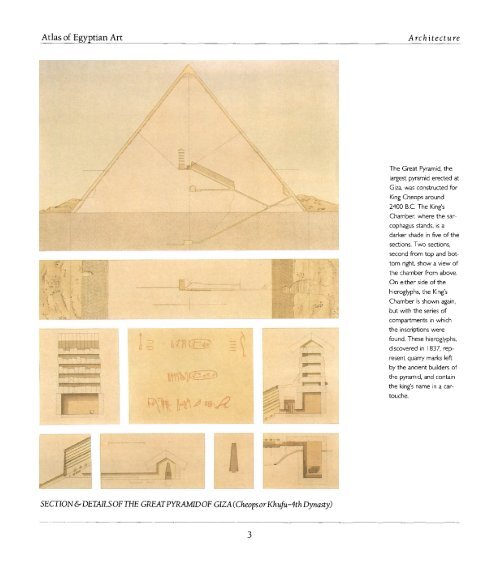Atlas of Egyptian Art
Atlas of Egyptian Art
Atlas of Egyptian Art
Create successful ePaper yourself
Turn your PDF publications into a flip-book with our unique Google optimized e-Paper software.
<strong>Atlas</strong> <strong>of</strong> <strong>Egyptian</strong> <strong>Art</strong><br />
<strong>of</strong> works done for Mr. Prisse" 10 (now in Leiden). In one month, they visited all the major Nubian temples, checking them against<br />
Prisse's records and adding new details. On October 6, the dahabiyeh returned through the cataract <strong>of</strong> Aswan. From there, the<br />
company floated down the Nile, halting at Kom Ombo, Silsileh, Edfu (which had since changed considerably as a result <strong>of</strong><br />
Mariette's excavations), el-Kab, and Esna.<br />
Upon arrival at Luxor, Prisse moved into his ancient quarters at the rear <strong>of</strong> the Karnak temple, where he found one <strong>of</strong><br />
Mariette's numerous excavation parties active in and around the hypostyle hall. On November 25, the expedition moved to<br />
Wardi's house—now deserted—on the west bank, for work in the private and royal tombs and in the funerary temples. Again,<br />
Prisse noted that much <strong>of</strong> the work done in the 1840s could not be collated because the originals had vanished. On the other<br />
hand, there was so much new material available in Deir el-Bahri, where excavations had recently been started by Maunier, the<br />
local consul <strong>of</strong> France, and in Medinet Habu, where Prisse was allowed to direct the excavations for Mariette. He also<br />
undertook some small-scale digging for the exiled Prince <strong>of</strong> Orleans.<br />
This took the entire winter, and it was not until April 14 that the expedition finally set sail for Cairo. There, Prisse accepted<br />
the hospitality <strong>of</strong>fered by Mariette in his house at Saqqara, and moved from there to the Giza pyramids, and finally finished<br />
by sketching some <strong>of</strong> the recent finds pouring into the Bulaq museum from Mariette's excavations. It is not surprising that<br />
Jarrot had a mental breakdown and had to be sent to France. Prisse and Testas followed, leaving Alexandria on June 12,1860.<br />
The result was that Jarrot immediately stopped his career as a photographer, Testas launched a career as a successful painter<br />
<strong>of</strong> oriental scenery, and Prisse would finally finish the publication project started 15 years earlier. He returned to Paris with a<br />
rich harvest <strong>of</strong> 300 drawings, 400 meters <strong>of</strong> squeezes, and 150 photographs. Before long, the first plates appeared <strong>of</strong> his<br />
monumental <strong>Atlas</strong> de I'histoire de I'art egyptien, d'apres les monuments, depuis les temps les plus reculesjusqu'd la domination<br />
romaine and its complement L'<strong>Art</strong> Arabe, d'apres les monuments du Caire, depuis le Vllesiedejusqu'd /a/in du XVlIle siecle. The<br />
former project lasted until 1877, apparently having started with a few plates in 1858, nearly twenty years earlier. The latter took<br />
from 1867 to 1879. These 359 plates did not even represent the full amount <strong>of</strong> Prisse's records, and it was the death <strong>of</strong> their author<br />
in 1879 which robbed us <strong>of</strong> the rest (though the original drawings have been preserved, mainly in the Bibliotheque Nationale).<br />
None <strong>of</strong> Prisse's contemporaries had the skill or endurance to bring such an endeavor to such a brilliant end. His<br />
combination <strong>of</strong> interests, with equal zeal for the Pharaonic and the Islamic periods, was quite unique. He was far ahead <strong>of</strong> his<br />
time in his awareness <strong>of</strong> the vulnerability <strong>of</strong> the monuments and the need to protect and record them. His were the first<br />
reliable drawings <strong>of</strong> <strong>Egyptian</strong> architecture and ornaments and the first plans and sections <strong>of</strong> constructions newly excavated.<br />
The present reprint <strong>of</strong> Prisse's <strong>Atlas</strong>, the plates <strong>of</strong> which have lost nothing <strong>of</strong> their value for modern Egyptology, is a fitting<br />
tribute to the memory <strong>of</strong> the great orientalist.<br />
Notes<br />
1. WR. Dawson and Uphill, E.P. Who was who in Egyptology, (London, 1972), 238.<br />
2. E. Prisse d'Avennes fils, Le papyrus a I'epoque pharaonique, (Avesnes, 1926).<br />
3. M. Du Camp, Souvenirs litteraires, (Paris, 1984),110 ff.<br />
IX


